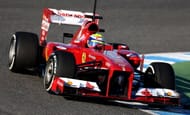After three of the most exhilarating consecutive seasons in Grand Prix history — although some believe Red Bull’s utter dominance of 2011 was on the boring side — Formula One seems headed for changes this year. The biggest issue, as typical in today’s post-recession global economy, is money.
Drivers Mark Webber of Australia and Sebastian Vettel of Germany reveal the new car during the Infiniti Red Bull Racing RB9 launch on February 3, 2013 in Milton Keynes, England.
F1 takes enormous amounts of capital and it’s just not around that much any more. Despite a resource restriction agreement that is designed to level the playing field and allow smaller teams to remain financially solvent (whether or not competitive), the gap between the sport’s leading organizations and grid backmarkers is as large as ever.
The signs of this situation are evident. Marussia, which started back in 2010 as Virgin, released Timo Glock in favor of yet another sponsored “pay driver,” who basically purchased the seat. Caterham let Heikki Kovalainen go in favor of a second paid seat alongside Charles Pic.
Paying for F1 drives is not new, going all the way back to Juan Manuel Fangio’s backing by the Argentine government of Juan Péron in the 1950s. But this time it feels different. The difference is that the F1 grid is shrinking, looking today like a far cry from the halcyon era of the early 1990s, when “pre-qualifying” was required to whittle the field to a “mere” 26 cars for Saturday qualifications. Former Toro Rosso driver Jaime Alguersuari, yet another casualty of the paid driver trend, complains that ”F1 has become an auction.”
For some years now, there have been whispers in Formula 1 that all was not well financially with some of the teams. Finally, one of the most senior figures in the sport has put a public voice to them. McLaren boss Martin Whitmarsh says “of the 11 teams, seven of them are in survival strategy.”
Formula 1 teams showing signs of money problems | BBC Sport.
This helps explain, in part, the relentless pursuit in recent seasons of new venues in developing nations (China, India, etc.) where government-subsidized circuits and rising consumer demand are hoped to help attract new commercial sponsors to the sport. But it is unsettling at best and scary at worst. With the advent of sporting regulation changes requiring engines, transmissions and other vital car parts to last for many races, the demise of special qualifying tires, spare cars and in-season testing, the basic parameters of F1 are shockingly different from its historical roots. Some see these as making competition better; others, like this author, see them as a threat to the fundamental nature of F1 as the epitome of automobile technology and engineering.
Yes, Formula 1 has in the past been most profligate in the area of spending. Rumors have it that Ferrari in its dominant Schumacher era was spending US$100 million a year on tires alone. Honda allegedly spent $1 billion during 2008 on the design of its 2009 car. (Ironically following Honda’s last-minute withdrawal from the sport at the end of 2008, the car they had designed for 2009 won both the drivers and constructors championships under the badge of Brawn GP.) And McLaren International’s yearly budget is said to reach nearly $300 million even today.
In some ways, the sport’s governing bodies are hurting themselves. In 2014, the current V8 engine specification is set to be abandoned in favor of new 1.6-liter turbo V6s. That may help the optics of F1, much like KERS has with its recent adoption by major auto companies for road cars as an efficiency and mileage-enhancing technology, yet the uncertainty and costs of switching formulas acts at cross-purposes to the goal of limiting capital budgets. Red Bull’s Christian Horner reportedly thinks 2014 is “going to be a risk for everyone,” in that “there could be more focus on economy than absolute performance.” It will undoubtedly cost a lot more to buy the new engines and even more to redesign chasses to work well with the smaller powerplant.
Whether that improves “the show” remains to be seen. In the mean time, debate continues to rage over the exclusion of privateers and so-called “customer cars,” which deprives the sport of the sort of small outfits that 40 years ago helped fill out the grid and launched the careers of such legends as Stirling Moss and Jackie Stewart. Way back in 2003, then FIA chief Max Mosley warned that Formula One couldn’t rely on manufacturer teams alone and needed to become more accessible for independents.

Felipe Massa of Brazil and Ferrari drives during Formula One winter testing at Circuito de Jerez on February 5, 2013 in Jerez de la Frontera, Spain.
Yet as we speak, the F1 teams are launching new cars and have returned from the 2013 season’s first official testing session at Jerez. There were many races in 2012 where the top 10 cars all qualified within 1s of each other. Overtaking, enhanced with DRS, is back big time. And everyone still chases the Adrian Newey-designed Red Bulls, despite signs that the Austrian team is no longer the technical wizard it was just two years ago.
Are you ready for some racing? Let’s hope the sport survives its financial troubles with its soul intact. See you in Melbourne.
